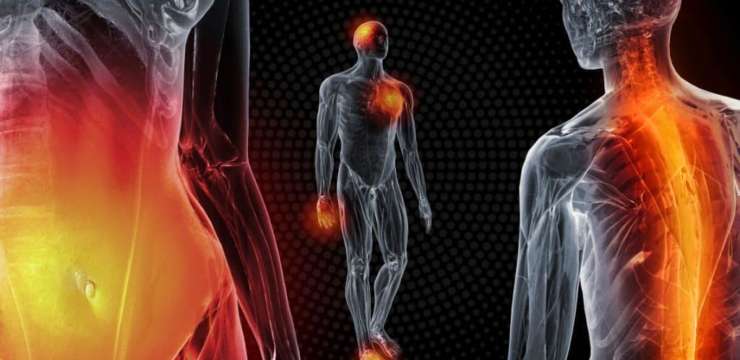Spinal disease, disk degeneration, and herniated disk are leading causes of pain radiation affecting movement and decreasing the patient’s quality of life. Nevertheless, technology in the biomechanical realm has provided multiple treatments, such as axial decompression, to ease the pain and slow the process of these degenerative conditions. However, biological factors may contribute to the healing process; it is well-known that diseases continuously deplete our nutrients pool. Therefore, proper nutrition and spinal decompression are crucial for spinal disease prevention and reversal.
Table of Contents
Disk nutrients:
The intervertebral spinal disk (IVD) is a highly specialized tissue with complex conformation and, therefore, nutrient-specific necessities. Indeed, nutrients and metabolism play a pivotal role in IVD’s constitution. For instance, glucosaminoglycans (GAGs) are critical for IVDs’ mechanical strength and integrity of the disk’s extracellular matrix. These GAGs are a metabolic product of glucose metabolism in combination with oxygen and lactate.
A wide array of nutrients are critical for ECM integrity and renewal, such as collagen, vitamin C, curcumin, glucose, proline, and lysine, among many others. Furthermore, proper supplementation is needed and recommended to maintain appropriate levels in our nutrient pool; promoting good nutrient delivery routes is crucial to preventing spinal degeneration.
Nutrient route: how to enter a disk?
The IVD is a highly specialized tissue, and part of its uncommon features is being avascular. This particular characteristic leads us to the following question: how do nutrients enter a disk?
There are two blood delivery routes:
- Capillary beds route: These locate on the cartilaginous endplate, and it is the main route that supplies the IVD with
- Peripheral annulus: This surrounds the nucleus pulposus (NP) and anchors the intervertebral disc to the vertebra.
Furthermore, their transport will differ depending on each nutrient’s molecular size. For instance, larger molecules such as glucosaminoglycans, enzymes, proteins, and hormones will use a gradient mechanism powered by the concentration of nutrients on any given side of the membrane. On the other hand, smaller molecules (glucose, lactate, oxygen) will use diffusion as their primary transportation mechanism.
Disk degeneration: risky environment and nutrition.
The interplay of decreased nutrition pools and structural failure creates an environment where disk degeneration is present. Indeed, nutrient metabolism is the main character in this play called disk renewal. The stage in which this story evolves becomes the main factor determining if this becomes a tragedy or a light-hearted play.
- Acidic environment: Glycolysis is the metabolic route that uses glucose to create ATP (energy) and lactate. Lactate production promotes an increased pH (between 7.0-7.3) in the center of the disk, and this is critical to fostering protein and proteoglycan synthesis. Nevertheless, low pH slows glycolysis, therefore less lactate production, contributing to a possible matrix breakdown.
- Proteoglycan loss: The loss of proteoglycans can be related to aging, as it increases with age. Furthermore, this decrease in proteoglycan synthesis can increase cytokine and enzymes in the disk, promoting a degeneration loop. Glycosaminoglycan’s function is to maintain hydration in the disk. Without them, the mechanical load can increase tissue stress and surface damage.
- Hydration and porosity: Diffusion relies on the membrane’s levels of porosity. A higher amount of water will require a bigger pore size to go through the membrane and present the glucose molecule. Therefore, a lower degree of hydration may compromise the number of small molecules that enter the disk.
- Density: Some authors report that 11% of cell density is lost when disk degeneration occurs. In this case, disk degeneration is due to a chronic shortage of nutrients. Furthermore, when low cellular density in a disk is present, intracellular signaling is limited, and since they locate near the endplates, nutrients cannot be transported.
- Metabolic demand: A disk packed with cells will need a greater nutrient demand, as well as a disk that is constantly stressed by mechanical load. Nevertheless, higher-density nutrients rely on their concentration and their transport mechanism. Therefore, some of these nutrients may not reach the disk’s center when cellular demand increases.
- Endplate permeability: The nucleus pulpous receives nutrients through the endplate and excretes toxic metabolites. Nevertheless, the endplates depend on their contact with the blood vessels and nutrient concentration. However, fractures may block the endplate compromising the nutrient delivery and toxin deposition. Furthermore, other factors contribute to this process: sclerosis and age-related mineralization may compromise the central endplate’s portion, blocking the most critical route of nutrient delivery.
Disk health is a multifactorial entity that relies on the interplay between what we do to maintain our disks, what we eat, and how these nutrients reach this tissue. A patient with nutritional deficiencies that comes into a chiropractic practice should not be unnoticed. Indeed, it is critical to assess the patient with disk degeneration from a holistic point of view. Supplying the proper amount of nutrients, enhancing or enabling the correct delivery pathway, and supporting metabolic pathways also decrease disk degeneration. – Ana Paola Rodriguez Arciniega, MS
Bibliography:
De Geer C. M. (2018). Intervertebral Disk Nutrients and Transport Mechanisms in Relation to Disk Degeneration: A Narrative Literature Review. Journal of chiropractic medicine, 17(2), 97–105. doi.org/10.1016/j.jcm.2017.11.006
Illien-Jünger, S., Gantenbein-Ritter, B., Grad, S., Lezuo, P., Ferguson, S. J., Alini, M., & Ito, K. (2010). The combined effects of limited nutrition and high-frequency loading on intervertebral discs with endplates. Spine, 35(19), 1744–1752. doi.org/10.1097/BRS.0b013e3181c48019
Disclaimers
Professional Scope of Practice *
The information herein on "Nutrients, Metabolism, and Disk degeneration" is not intended to replace a one-on-one relationship with a qualified health care professional or licensed physician and is not medical advice. We encourage you to make healthcare decisions based on your research and partnership with a qualified healthcare professional.
Blog Information & Scope Discussions
Welcome to El Paso's wellness blog, where Dr. Alex Jimenez, DC, FNP-C, a board-certified Family Practice Nurse Practitioner (FNP-C) and Chiropractor (DC), presents insights on how our team is dedicated to holistic healing and personalized care. Our practice aligns with evidence-based treatment protocols inspired by integrative medicine principles, similar to those found on dralexjimenez.com, focusing on restoring health naturally for patients of all ages.
Our areas of chiropractic practice include Wellness & Nutrition, Chronic Pain, Personal Injury, Auto Accident Care, Work Injuries, Back Injury, Low Back Pain, Neck Pain, Migraine Headaches, Sports Injuries, Severe Sciatica, Scoliosis, Complex Herniated Discs, Fibromyalgia, Chronic Pain, Complex Injuries, Stress Management, Functional Medicine Treatments, and in-scope care protocols.
Our information scope is limited to chiropractic, musculoskeletal, physical medicine, wellness, contributing etiological viscerosomatic disturbances within clinical presentations, associated somato-visceral reflex clinical dynamics, subluxation complexes, sensitive health issues, and functional medicine articles, topics, and discussions.
We provide and present clinical collaboration with specialists from various disciplines. Each specialist is governed by their professional scope of practice and their jurisdiction of licensure. We use functional health & wellness protocols to treat and support care for the injuries or disorders of the musculoskeletal system.
Our videos, posts, topics, subjects, and insights cover clinical matters, issues, and topics that relate to and directly or indirectly support our clinical scope of practice.*
Our office has reasonably attempted to provide supportive citations and has identified the relevant research studies or studies supporting our posts. We provide copies of supporting research studies available to regulatory boards and the public upon request.
We understand that we cover matters that require an additional explanation of how they may assist in a particular care plan or treatment protocol; therefore, to discuss the subject matter above further, please feel free to ask Dr. Alex Jimenez, DC, APRN, FNP-BC, or contact us at 915-850-0900.
We are here to help you and your family.
Blessings
Dr. Alex Jimenez DC, MSACP, APRN, FNP-BC*, CCST, IFMCP, CFMP, ATN
email: coach@elpasofunctionalmedicine.com
Licensed as a Doctor of Chiropractic (DC) in Texas & New Mexico*
Texas DC License # TX5807
New Mexico DC License # NM-DC2182
Licensed as a Registered Nurse (RN*) in Texas & Multistate
Texas RN License # 1191402
ANCC FNP-BC: Board Certified Nurse Practitioner*
Compact Status: Multi-State License: Authorized to Practice in 40 States*
Graduate with Honors: ICHS: MSN-FNP (Family Nurse Practitioner Program)
Degree Granted. Master's in Family Practice MSN Diploma (Cum Laude)
Dr. Alex Jimenez, DC, APRN, FNP-BC*, CFMP, IFMCP, ATN, CCST
My Digital Business Card






